Review: #21058 Great Pyramid of Giza
Can a LEGO set based on an undecorated pyramidal shape earn the Architecture label? Possibly — especially when placed into the context of the era when it was built.
#21058 Great Pyramid of Giza is the latest addition to the LEGO Architecture series and priced at $129.99 (139.99€ / £124.99 / 169.99 CAD / 229.99 AUD) for 1476 pieces, ages 18+. At that price, the set comes to just $0.088 per piece in the USA, which is a pretty good price, especially given that the set includes lots of larger parts like 2×4 Bricks and Slopes.
The set will be available in June 1, 2022 in Europe, but in the United States we need to wait for an August 1 release date. (This has been an persistent frustration for Summer LEGO Architecture releases in North America.) Unlike many licensed sets, there is no option to preorder at this time.
First Impressions
Box in hand
I am sitting on the cautious side of optimism as I open the package, revealing a larger box than we have seen in previous LEGO Architecture sets. The Pyramid is also in an unexpected stark white color! The basic construction technique involves stacking basic slopes as I had expected, identical to the building technique used for the tiny Luxor hotel in #21038 / #21047 Las Vegas Skyline — but at a much larger scale.
Thankfully a first glimpse of the box exceeds my (modest) expectations. This is largely due to the choice to re-create a larger landscape including the Nile River and smaller architectural details as they may have appeared when the pyramid was first built.
On the other hand, I don’t love that we only get the “front” side of the pyramid, although I’m sure many folks will buy a second copy to complete the pyramidal shape. The photos on the back of the box explain this choice better — it reveals a cross-section of the pathways inside the pyramid. We also learn that the finished white exterior is removeable, revealing a scene showing how the pyramid was likely built!
I’m still not sold how well this fits within the core Architecture series, but I’m excited to start building… and that’s a good sign!
Contents
The set does not come in a premium recloseable box, continuing a disappointing trend started by #21057 Singapore Skyline. It is nonetheless a decent quality box, which will be easy to store flat if you cut the tape seals on both ends of the box. (This does make it easier to safely store boxes from your favorite sets, though!)
It is, however, a pretty heavy box given the part count — No doubt influenced by what I expect will be a lot of 2×4 Bricks and 2×4 Slopes.
Box Contents:
- Stage 1: 1x large bag (marked 110H2), 1x large bag (marked 210H2).
- Stage 2: 1x large bag (marked 310H2), 1x small unmarked bag.
- Stage 3: 1x large bag (marked 109H2).
- Stage 4: 1x large bag (marked 310H2).
- Stage 5: 1x large bag (marked 509H2), 1x large bag (marked 510H2).
- Stage 6: 1x medium bag (marked 310H2).
- Stage 7: 1x large bag (marked 209H2), 1x medium unmarked bag.
- Stage 8: 1x large bag (marked 310H2), 1x small unmarked bag.
- 176-page instruction booklet. 27 x 19.2 cm (10 5/8 x 7 1/2”) in bag (marked 641550).
Build Process
The build process is familiar to anyone who has built previous sets in the LEGO Architecture Skyline series… We will begin with a strong base that is three plates tall and mostly covered in smooth tiles.
Stages 1 & 2 – Base
The first bag immediately confirms a few of my predictions about the set: that it is packed with larger parts than we are used to seeing in the Architecture series, and that it’s going to be a BIG model when it’s complete. The base is a maze of crisscrossing bricks and plate in a range of bright and muted colors, with blue pieces near the front aligning with where the Nile River will appear.
The signature black tile edge used throughout the LEGO Architecture series is present on all of the sides except the back, which is flat, save for two technic axle holes which are clearly present in case you decide to buy two copies of the set and place them back-to-back. (Some modification would be required if you want to address the fact that there is only one Nile River in Egypt.)
For two large bags of parts, it goes together quickly, encouraging you to keep building to see what’s next!
The second bag adds layers of topography to the front of the model, which includes a rather unusual selection of colors that appear to be covered with clear tile in the next step. It’s hard to imagine the pattern made by 141Earth GreenDark Green, 107Bright Bluish GreenDark Turquoise / Teal, 138Sand YellowDark Tan, 330Olive Green and 192Reddish Brown plates bleeding color through to the river above.
In the back of the model, we build up the base of the pyramid, which has a smooth recessed area where I expect that the removeable pyramid cover will rest. Along the back edges, a simple technique with 5Brick YellowTan bricks creates the effect of rippling sand dunes.
Build time: 32 minutes (Stage 1: 14 minutes, Stage 2: 18 minutes).
Stages 3 & 4 – River and smaller structures
The third bag contains just one bag but contains a lot of smaller parts, which is why it took a lot longer than the previous two. It begins by carefully positioning 42Transparent Light BlueTrans-Light Blue tiles and plates to cover the assortment of colors we arranged in the previous stage. The effect is a bit murky and blocky, but I can see how this is meant to portray depth.
From here, we work our way up the hill adding 141Earth GreenDark Green along the shoreline, and 138Sand YellowDark Tan layers as we move further up. We also add a panel to the hole in the right side, which also includes nice topographic detailing.
The real highlight is that we finally get to build some Architecture, with three sphinxes flanking the left side of the ramp, and a collection of tan structures on the right side which might be workers housing (or a cemetery).
In the fourth bag, we finish both the foliage and the smaller architectural details in the front of the model. This begins with a rectangular sub-assembly that fits in the space on the left side of the model, which contains two smaller pyramids. While it is obviously not to scale, they included a nice detail hidden inside each of the pyramids — a stone sarcophagus.
We continue by adding a meticulous arrangement of 1×1 and 1×2 rounded parts with hollow studs, into which we place about 50 tiny palm trees, and six taller trees. The effect is pleasing and improved by the decision to use two different shades of green to give a variegated look.
Finally, we wrap up this collection of brick-built Egyptian architecture with a proud structure jutting out into the water. It employs 1×4 flat gears to create the effect of a jagged roofline.
Build time: 46 minutes (Stage 3: 23 minutes, Stage 4, 23 minutes).
Stages 5 & 6 – Pyramid under construction
Easily the most unexpected element of this model is the way in which we get to see both a vignette of the building under construction as well as the finished structure. In the fifth bag, we build most of the “under construction” part. This includes some admittedly very boring brick stacking, as well as some moderately interesting techniques to create the angled ramp where part of the golden top of the pyramid is being lifted into position.
The sixth bag continues where we left off, adding just a few more layers to the top (and back) of the pyramid, including a section on the back assembled using an inverted assembly to create the v-shaped passageways. We also add a few areas of scaffolding, and the rope winch being used to pull the block up the inclined plane using a winch.
This is also when we place a selection of 1×1 and 1×2 tiles in 5Brick YellowTan around the pyramid in a somewhat random pattern. I am not quite sure what this is meant to mimic, but it does give the effect of an unfinished structure by breaking up the visible studs.
Build time: 40 minutes. (Bag 5: 23 minutes, Bag 6: 17 minutes)
Stages 7 & 8 – Top of Pyramid
It’s time to finish this up by building a removeable lid showing the finished pyramid. The seventh bag creates a c-shaped base upon which uses eight Stairs 7×4×6 (part 30134) attached as a sort of scaffolding for the rest of the pyramid that follows. It’s a clever solution that adds strength using only a small number of parts.
We continue building the pyramid in the eighth bag, which uses four more of those stair pieces to make it stronger. It goes quickly as with the previous bag, and is topped with a 299Warm Gold Drum LacqueredMetallic Gold piece.
I thought that would be the very final step, but there are few dozen pieces left over after the pyramid is complete. These final steps add two boats on the river and a tall obelisk on the right hand side of the model.
Build time: 28 minutes. (Bag 7: 12 minutes, Bag 8: 16 minutes)
Parts
The set is not a great source for new parts or recolors, but it does offer some common parts in large quantities. This, plus the comparably good value make this a decent parts pack.
Existing parts in new color:
- 2x – 2×1 Triple slope (part 15571) in 299Warm Gold Drum LacqueredMetallic Gold.
Printed Parts:
- 1x – 1×8 Tile (part xxx) with “The Great Pyramid of Giza” in 26Black.
- 1x – 1×8 Tile (part xxx) with “Hieroglyphics” in 26Black.
Parts in Notable Quantities:
- 100x – 2×4 Slope (part 3037) in 1White.
- 12x Stairs 7×4×6 (Part 30134) in 199Dark Stone GreyDark Bluish Gray.
- 17x – 2×6 Bricks (part 2456) – 6x in 1White, 6x in 5Brick YellowTan, and 5x in 194Medium Stone GreyLight Bluish Gray.
- 54x – 2×4 Bricks (part 3001) – 21x in 5Brick YellowTan, 26x in 138Sand YellowDark Tan, 5x in 141Earth GreenDark Green, and 2x in 194Medium Stone GreyLight Bluish Gray.

Small white text on light gray background is hard to read, and there is an error on the last page where part numbers overlap part images.
Value
With a $129.99 price, this set represents a pretty good price-per-piece at $0.088 per piece; below the long-standing benchmark of $0.10 per piece. That said, I find this to be an unsatisfactory measure of value, since a lot of recent sets include a huge number of tiny parts.
If we consider price-per-gram, things are looking pretty good… $0.071 per gram compares favorably to all of the sets I’ve analyzed so far, with only the World Map offering a better value based on this metric. (While this is a new metric, anything under $0.10 per gram seems to be good – suggesting that an “average” LEGO piece is around 1 gram.)
Assessing value compared to a selection of popular recent sets:
| LEGO Set | Price | Part Count | Price-per-part | Weight | Price-per-gram |
|---|---|---|---|---|---|
| #31203 World Map | $249.99 | 11,695 pieces | $0.021 per-piece | 4020 grams | $0.062 per-gram |
| (This Set) #21058 Great Pyramid of Giza | $129.99 | 1476 pieces | $0.088 per-piece | 1832 grams | $0.071 per-gram |
| #10292 Friends – The Apartments | $149.99 | 2048 pieces | $0.073 per-piece | 1778 grams | $0.084 per-gram |
| #10297 Boutique Hotel | $199.99 | 3066 pieces | $0.065 per-piece | 2380 grams | $0.084 per-gram |
| #10282 Adidas Originals Superstar | $79.99 | 731 pieces | $0.109 per-piece | 735 grams | $0.109 per-gram |
| #21057 Singapore Skyline | $59.99 | 827 pieces | $0.072 per-piece | 411 grams | $0.146 per-gram |
Sorted by price-per-gram, we see that this set is actually about about average (based on this small selection of sets). It’s interesting to see sets laid out in this way — you can really see how much more a premium licensed set like the Adidas Originals Ultrastar can cost compared to other sets. Likewise, a set in the LEGO Architecture series can seem like a good value from a price-per-part perspective, but only because the set contains a ton of tiny parts!
More like this?

Subscribe to the Brick Architect newsletter for early access to exclusive content, the latest articles, and updates to the Printable LEGO Brick Labels, LEGO Storage Guide, and my book The LEGO Architect.
Historic Context
While I do not want to pretend that I am an expert in Egyptology, I did take some time to compare the finished model with the actual Giza site. As noted in the name of the set, the large pyramid featured in this set represents the “Great Pyramid of Giza” which is the largest of the three main pyramids at the Giza site. It is dedicated to Khufu (also referred to as Cheops), the Pharaoh who died in 2566 BCE, six years after the Pyramid was completed.
The set shows the pyramid as viewed from the east, which is why the Nile River is depicted along the front edge of the model. Nowadays, the river is controlled by dams, but in the era of the Pharaohs, the river flooded for several months of each year, nearing the site where the Pyramids were located. Thusly, we can assume that the model is meant to depict when the river was flooded, or perhaps reflecting a theory that canals were used to access the site year-round.
The complex accurately reflects my understanding of architectural style and technology of the era. Preceding the invention of the Roman or Gothic arch, columns were used extensively but had to be placed close together to support a heavy flat stone roof. Sloping walls were also commonly used, reflecting a practical reason – walls need to be thicker at the base to achieve a great height.
Given the inaccuracy of the grounds compared to the actual site, the entire model should be seen as representational instead of accurate. Even if it isn’t perfect, the design of the model is rooted in the architectural tradition of the period and the reality that the river flooded annually. This makes the model effective at capturing the ‘feel’ of the site.
Conclusion
#21058 The Great Pyramid of Giza is an interesting model that takes the LEGO Architecture series in a new direction. The finished model has a greater focus on storytelling and education than on pure architectural forms, especially the hidden vignette showing the pyramid under construction. It does make me wonder if there is a plan in place to re-create all of the classic “wonders of the world”, which (depending on the list) can also include #21041 Great Wall of China.

The finished model is larger than expected, especially compared to other sets in the Architecture series.
I’ll admit that I prefer contemporary architecture and the smaller scale used in earlier sets in the Architecture series (especially architecturally important buildings like Fallingwater). I find that this set is awkwardly sized compared to previous sets – twice as big as previous sets in the LEGO Architecture series, and half as big as sets in the Creator Expert Landmark series. This makes it a harder sell for current collectors.
That said, this is actually a really good set which has a lot to offer for the right builder. That’s why it earns our Excellent (4/5 star) rating based on its merits as a great LEGO Set. The build experience is engaging, it offers an above-average value, and the finished model looks good thanks to the addition of smaller architectural details and landscaping in front of the pyramid.
Despite the high rating, this is not an instant buy for established collectors of the LEGO Architecture series. The model is stylistically different from other sets in the series and is enough larger that you need to have a lot of space on your shelf before adding this to your collection. It is also much more representational than other sets in the series, with the foreground elements only bearing a passing resemblance to the actual site. On the other hand, people who love the Creator Expert Landmark series may really enjoy this set as it offers a similar feel but at a lower price point (unless you buy two copies in order to construct a complete pyramid).
One other net-new audience that this set may appeal to are history buffs and educators. The inclusion of a vignette exploring how the pyramids may have been built and the selection of period-appropriate buildings in front of the pyramid makes this into an interesting discussion piece in a learning setting.

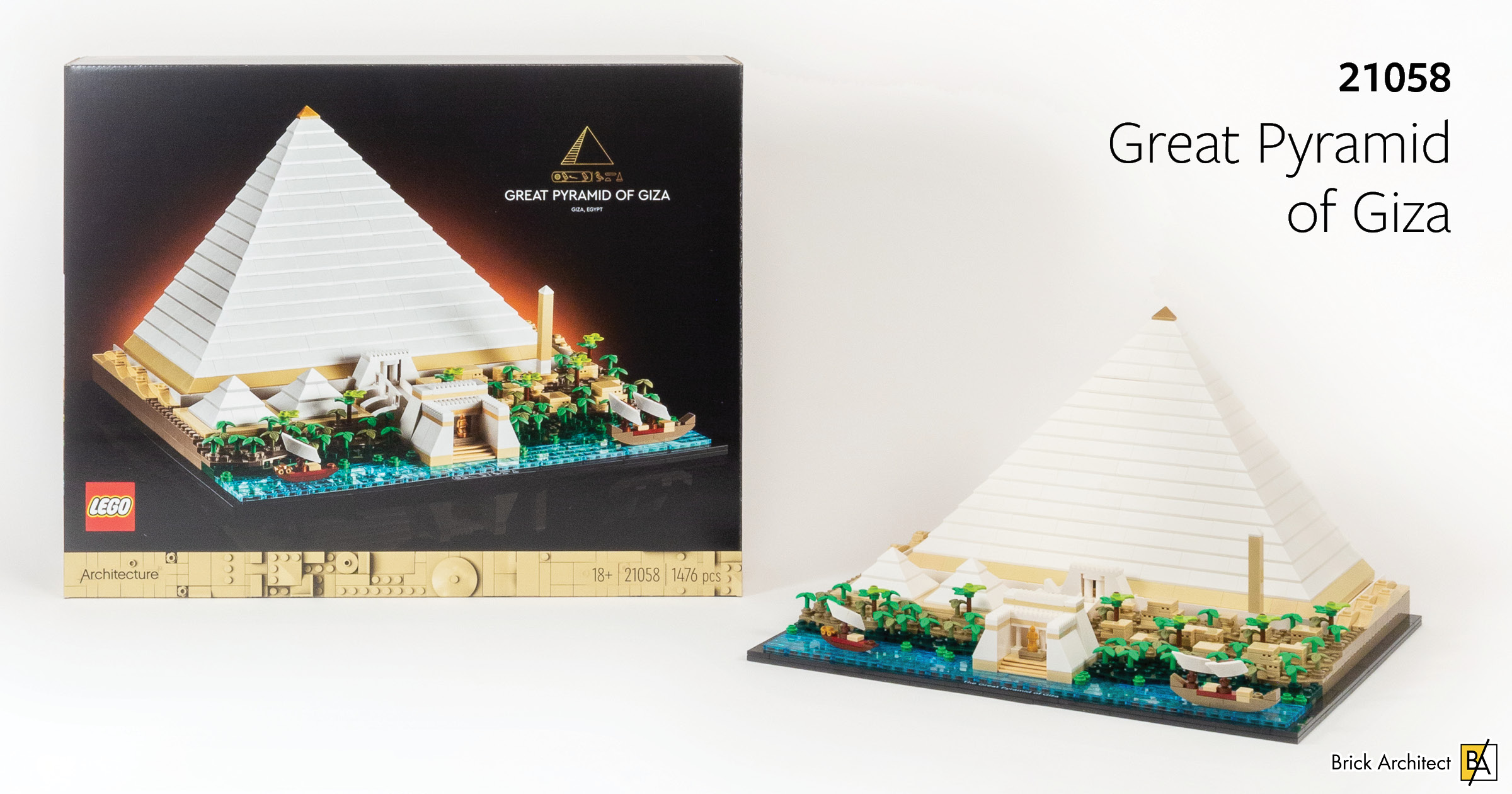
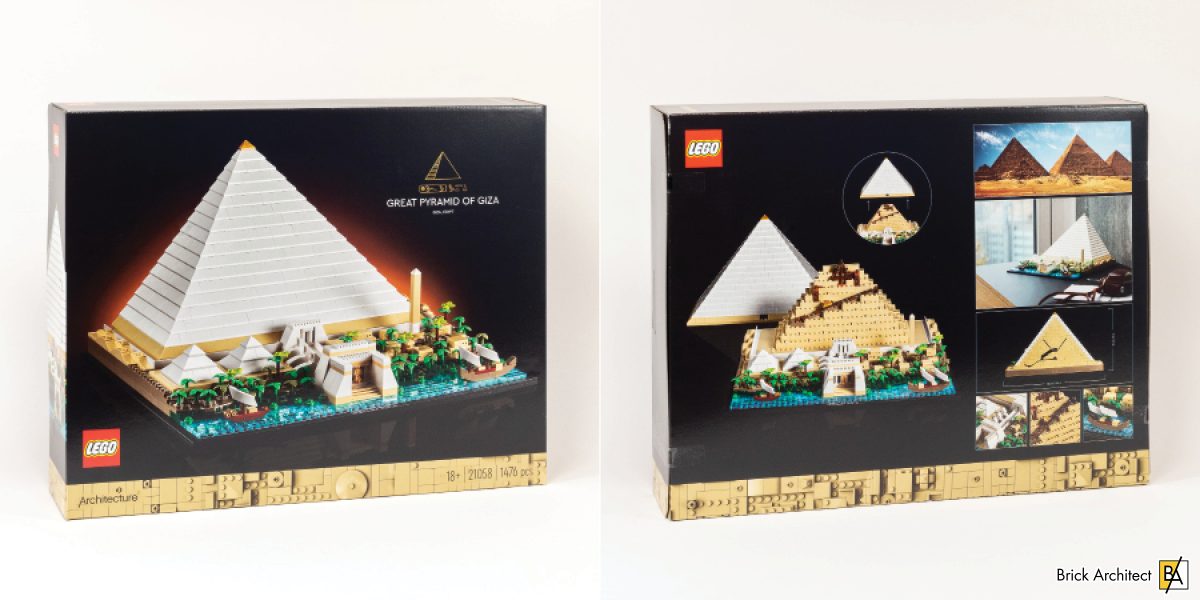
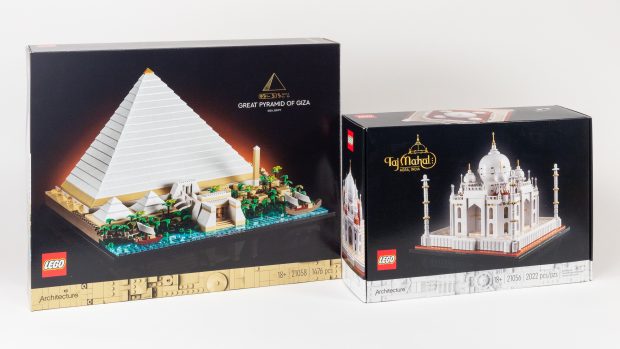
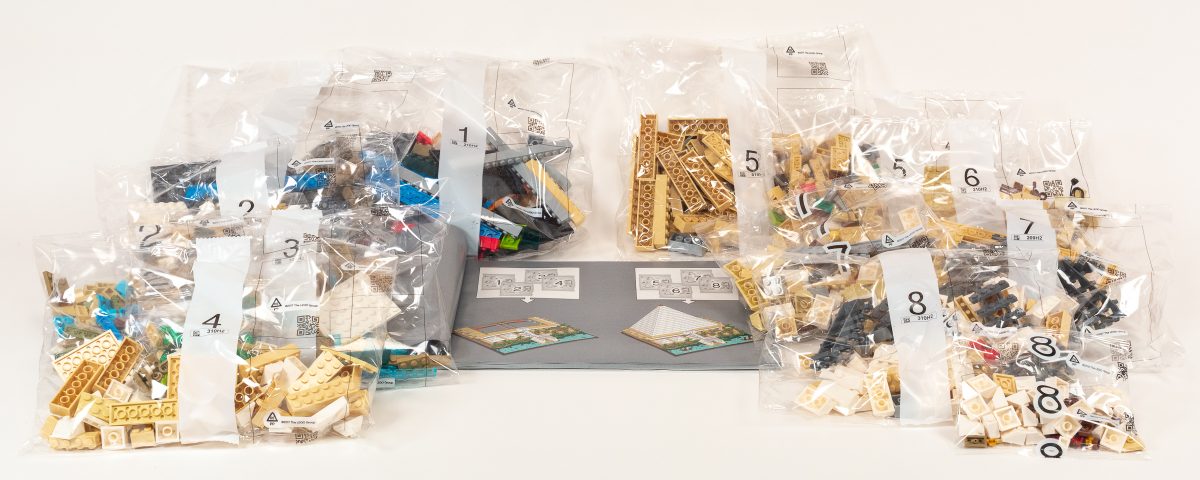


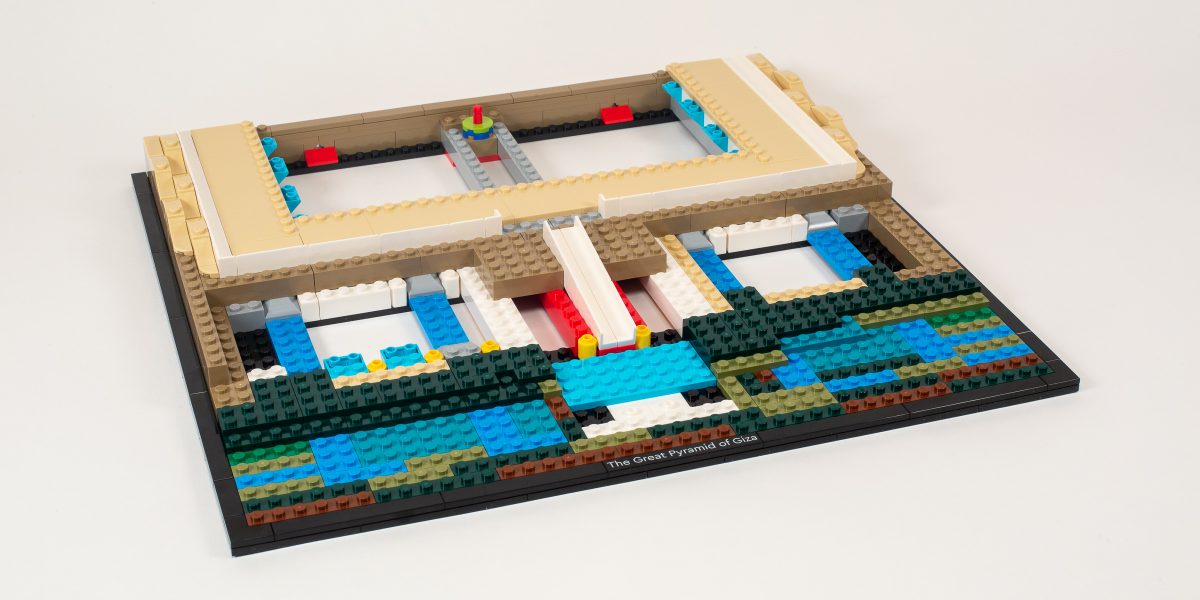
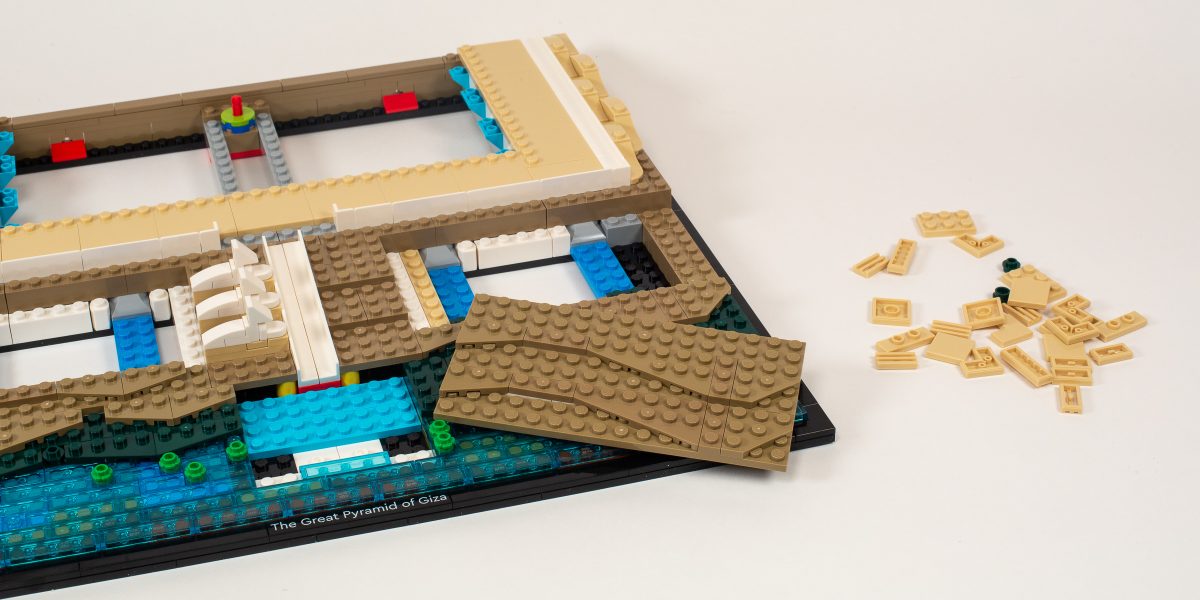
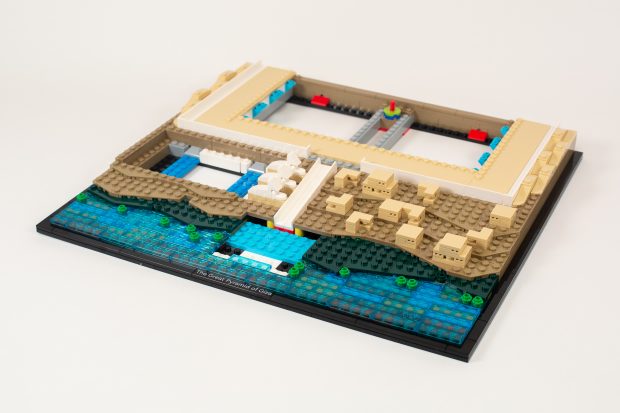
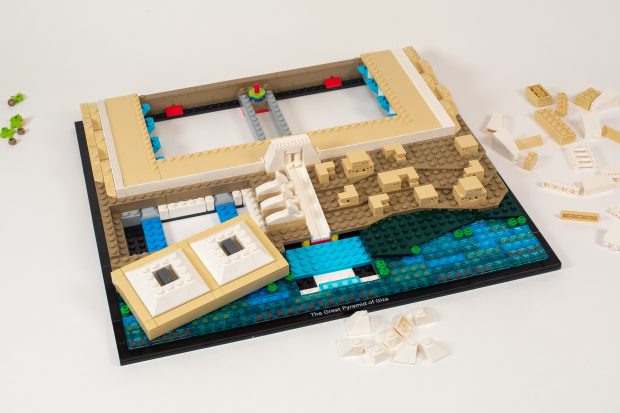
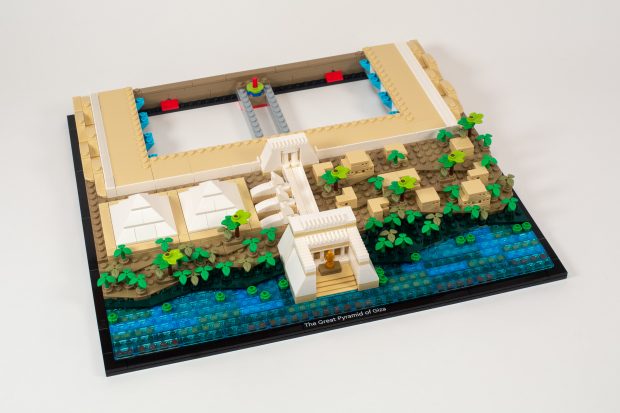
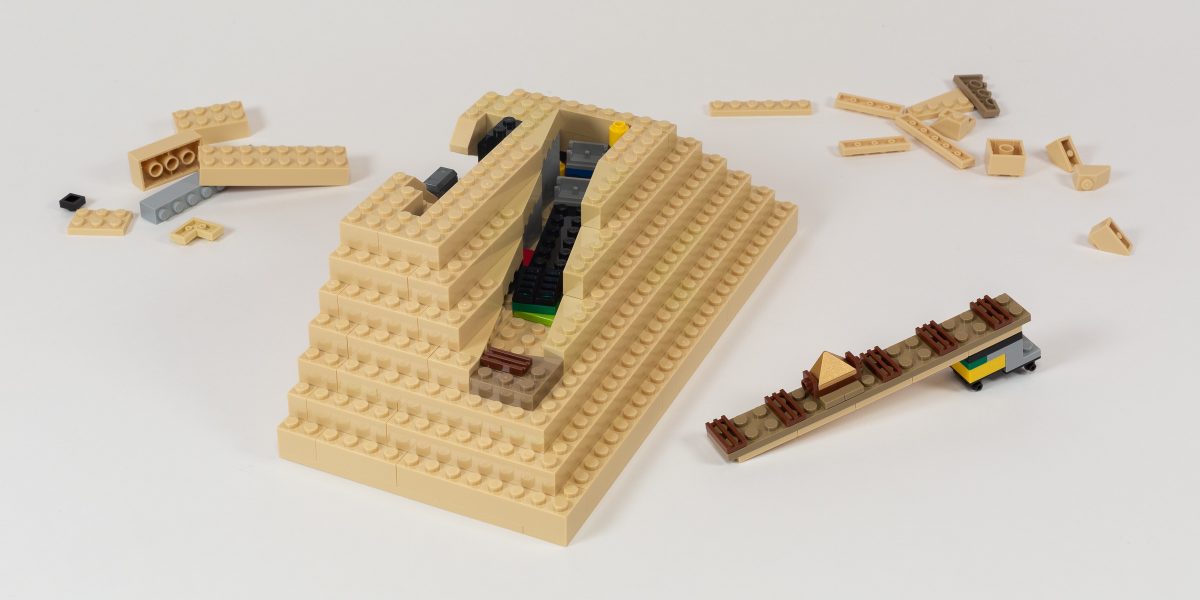

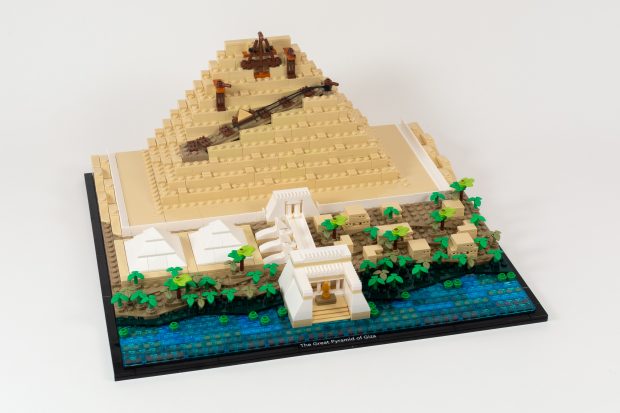
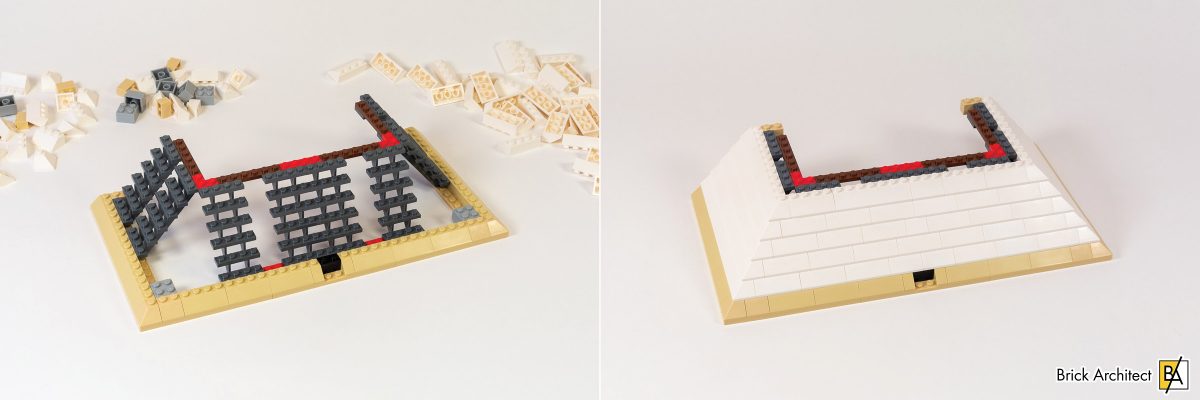
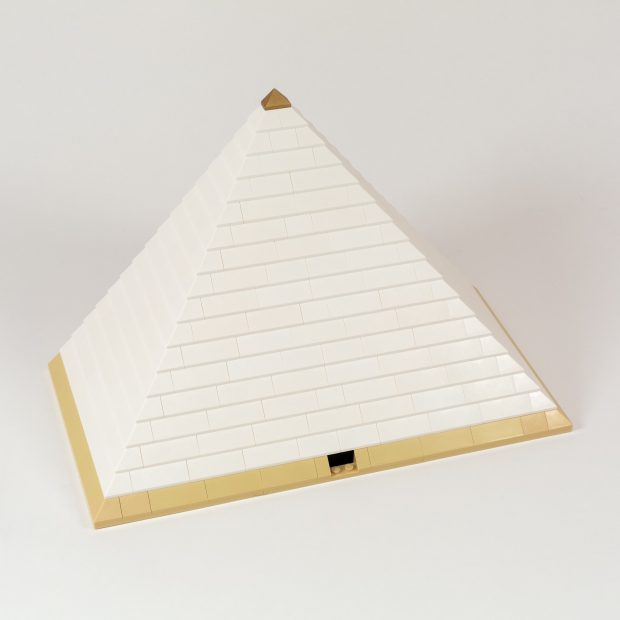


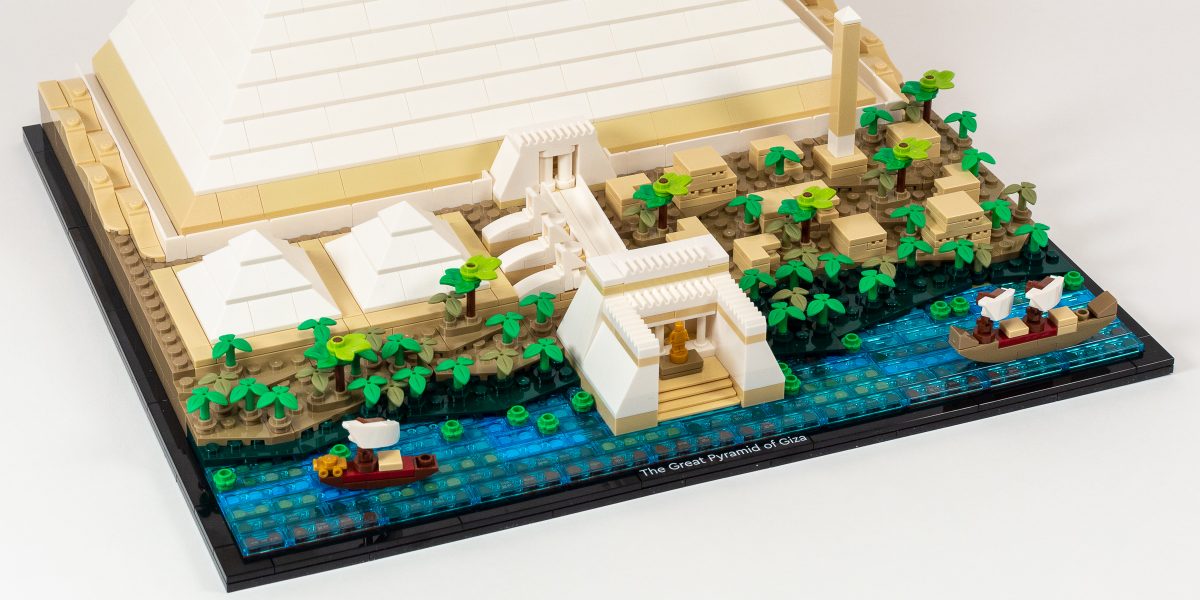
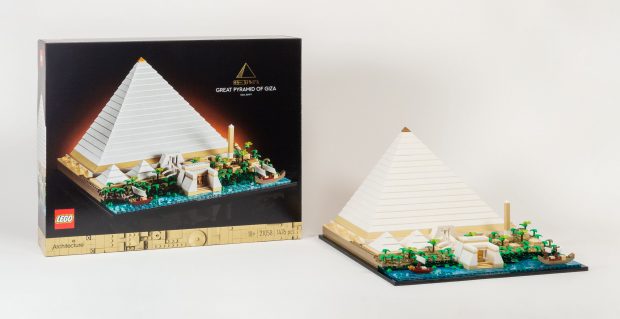
The instructions do say that the collection of buildings on the right is housing for the workers who are building the pyramid.
Any idea what the red Technic axel pin is there for?
It is not explained in the book, but I strongly suspect that it is there in case you want to attach two copies to create a complete pyramid. (There are two exposed axle holes on the back of the model).